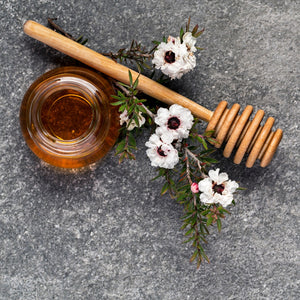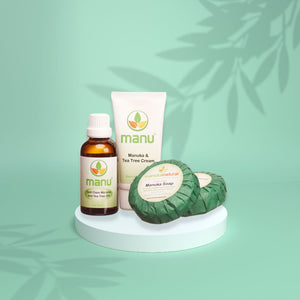
Keeping the Volume in your Cheeks with Rosehip oil and Manuka honey
More to smile about: Manuka honey and Rosehip oil for loss of volume in cheeks
General loss of volume in cheeks begins between 30-35. And changes begin to take place in every layer of the skin. The reason for that is a combination of internal processes and external factors.
And what haven’t you tried by now to diminish those factors?
General skin aging and loss of volume in cheeks
The beauty triangle
The way we age depends in part on genetics. However, internal aging, combined with environmental and lifestyle factors are triggers that are slowing down key processes and functions in the skin.
The shape of your face changes over time, which can be first seen by the loss of volume in the cheeks.
The triangle of beauty is associated with a youthfully attractive appearance
The youthful face is adorned with a distribution of volume that creates an attractive appearance. The main features of a young face can be seen as a “beauty triangle.”
But, the slowing down of the process causes the most visible signs of aging:
Fine lines and wrinkles
Loss of volume in cheeks
Loss of elasticity
Lack of radiance
The key change to blame for these vivid signs is reducing the number of cells providing volume.
Sometimes it is difficult to define, but the loss of volume is prevalent and changes the structure and shape of the whole face. For example, loss of volume makes facial skin look older.
You can sometimes describe it as sagging skin, loss of contours, or a face with a sad expression.
The beauty triangle turns over time, which leads to a person’s perception as gloomy or sad.
The combination of these factors results in an outdated appearance. As seen here, the triangle is now turned upside down, and the wider area is at the bottom of the face.
As the volume decreases and the skin relaxes, the perception of the face changes. Now this face can be interpreted as sad or exhausted.
Contributing factors to loss of volume in cheeks
Why does the beauty triangle change?
In addition to chronological, internal aging, many factors contribute to the processes that lead to volume loss.
HORMONAL CHANGES
The concentration of estrogen in puberty is high. As a result, the skin is smooth and elastic, and the contours of the face are defined. However, hormone levels decline as we age, and the cells that provide volume decrease in number and size, leading to a loss of volume and defined facial contours.
During menopause, women especially experience a change in hormonal balance.
LIFESTYLE
For general skin aging, which includes loss of volume, the same external factors of lifestyle are responsible for wrinkles and loss of elasticity and luminosity.
Smoking: Nicotine and chemicals in cigarettes contribute to the breakdown of collagen in the skin.
Sun: Excessive sun exposure contributes to further damage to collagen and disruption of skin structure. Skin tolerates sun exposure differently, depending on skin type and condition.
These factors of life habits in combination lead to oxidative stress. This happens when free radicals form in us and attack cellular structures, including those that make the skin look taut and smooth.
When the structure weakens, the amount of collagen and elastin decreases, the general aging of the skin accelerates. Visible signs, including fine lines and wrinkles, volume loss, elasticity, and radiance, become more visible on the surface.
Why does a loss of volume in cheeks occur?
Processes and systems in the skin slow down over time, and each contributes to the general aging of the skin. The most important part of this problem is the gradual decline in the number of substances that “fill” the skin and make it firm and smooth to the touch, which leads to loss of volume, sagging skin, and weakened facial definition.
This occurs in the following areas of skin structure:
1 – Epidermis 2 – Deeper layers of skin
Epidermis. As we age, the upper layers of the skin produce less hyaluronic acid and fewer lipids. As a result, the skin’s ability to bind moisture is lower. As a result, the skin becomes drier and delicate lines and wrinkles appear. The skin also looks thinner, and its texture is dry and rough.
Deeper layers of skin. 1% loss of collagen mass per year and a decrease in elastin levels lead to thinning of the skin. Elastin is partly responsible for the elasticity and strength of the skin, and the reduction of these two substances in the skin leads to less skin elasticity.
Cells that give the skin volume and the appearance of the nucleus are also reduced in number and size, leading to the shrinkage of these layers. The result is a sad expression with an ‘inflamed eyebrows’ look.
Over time, blood flow to the upper layers of the skin, which supplies nutrients and oxygen, decreases, resulting in loss of skin freshness, dehydration, and less ability to heal wounds.
More profound struggles are now a certainty. And with the further loss of elasticity, deep wrinkles begin to form.
Solutions. How can I restore the volume to my cheeks?
INVASIVE DERMATOLOGICAL TREATMENTS
Cheek implants
This procedure gives the most lasting results. A plastic implant is placed under the skin to restore volume to certain areas, most commonly the cheeks. Although more popular initially, such treatments are now less in demand than fillers and fat transfer because they imply the most prolonged recovery period.
Fat transfer
This treatment involves surgically removing fat from one part of the body and transferring it to another. It is most often used to restore volume to the cheeks and has long-lasting effects. However, swelling is a common side effect, and treatment usually requires a period of rest.
Fillers
Injectables are used to restore volume and give fast, short-lived results temporarily. They are usually used for the area under the eyes, cheeks, temples, and lips.
Hyaluronic acid injections can also help with wrinkles.
HOW TO RESTORE VOLUME TO YOUR FACE NATURALLY? (NON-INVASIVE NATURAL TREATMENTS)
Although volume loss is a complex problem that is largely inevitable, the visible effects can be treated in various natural ways with active ingredients.
Preparations containing the following ingredients can counteract the causes of skin relaxation, loss of volume in cheeks, and other facial contours. Manuka Natural contributes to returning the face’s youthful appearance by solving these problems.
Rosehip oil
Rosehip oil’s anti-inflammatory and antioxidant properties help reduce all signs of skin aging, including wrinkles, fine lines, and blemishes. This oil can also inhibit the excessive production of melanin, which is responsible for the pigment in your skin.
Rosehip oil can protect against inflammation and damage caused by UV radiation. In addition, the content of antioxidants and fatty acids has a significant contribution to increasing cell longevity and preventing damage to cell membranes.
Vitamins A and C stimulate collagen production and offer ‘tuning’ of the cheeks.
Rosehip oil is easily absorbed into the skin. Its essential fatty acids stimulate collagen production and soften and moisturize the epidermis. In addition, fatty acids are converted into prostaglandins, which then stimulate your skin’s regenerative powers.
They reduce wrinkles (especially around the eyes) and fine lines. Rosehip oil also contains lycopene, which has skin rejuvenating properties.
So if you want to avoid the use of chemicals on your face, rosehip oil can be a good option.
Grapeseed oil
I was excited to discover that women in Ancient Greece used grapeseed oil for their skin six thousand years ago.
I read about how it’s reported that the ancient philosophers would use this as a traditional medicine to achieve hydrated-looking skin!
So, when you need that lit-from-within glow, there’s nothing better than grapeseed oil. It contains vital skin-friendly ingredients such as vitamin E and omega 6 fatty acids which help your complexion look healthy without makeup!
Also, it has carotenoids, phenolic acids, tannins, stilbenes, a large quantity of gallic acid, and resveratrol. (1)
On the other hand, grapeseed oil is made of up to 70% linoleic acid, which was proven to play a key role in repairing the skin’s barrier. Therefore strengthening it and reducing the appearance of dry skin, often connected with aging. In addition, these compounds are potent antioxidants, protecting the skin cells from oxidative stress from UV radiation and the environment.
The studies show that the antioxidants contained in the grapeseed oil are more biologically active than their synthetic equivalents.
Source: The Potential of Plant Phenolics in Prevention and Therapy of Skin Disorders Int J Mol Sci. 2016 Feb; 17(2): 160. Green B. et al. Grape seed proanthocyanidins increase collagen biodegradation resistance in the dentin/adhesive interface when included in an adhesive. J Dent. 2010 Nov; 38(11): 908–915.
Manuka honey & Bee venom
Bee Venom is a natural ingredient that can help you combat a loss of volume in cheeks. It contains collagen-making molecules called Hyaluronic Acid, which are absorbed by the body to increase moisture in cells. Furthermore, it also increases their strength for more extended periods!
This makes it perfect if you have sensitive or aging faces because these types will reap all these benefits without any adverse side effects from chemicals found within commercial products.
With manuka honey, it restores dry, sagging, dull, and creepy-looking skin to its natural splendor. In addition, Manuka Honey works as a natural moisturizer, drawing vital moisture into the skin. This hydration helps improve skin elasticity and cell regeneration, leaving your skin with a youthful glow.
In the end…
So, where does that leave you?
As always, Manuka Natural products leave you with an answer.
Beetox Sunrise – Illuminating Day Cream
We’ve taken the regenerative properties of Bee venom and blended them with age-defying Rosehip oil and enriching Grape-seed oil to stimulate the production of collagen and elastin, leaving you with a smooth and youthful glow.
And you can use it all over your face knowing that it does work.
AND, it will take only 20 days to start seeing differences in your beautiful only ladylike smile.
ORIGINALLY PUBLISHED on blog.manukanatural.com



Leave a comment